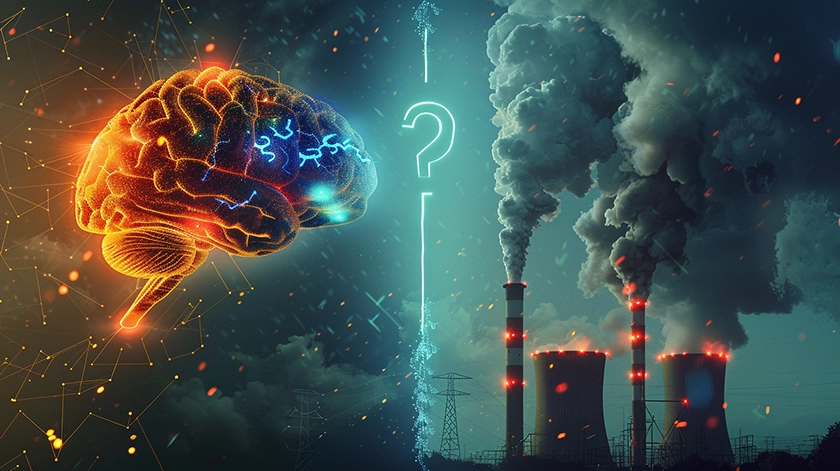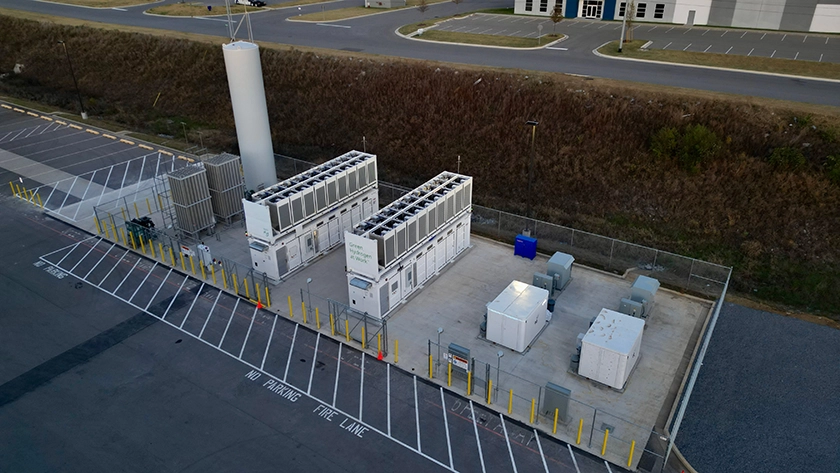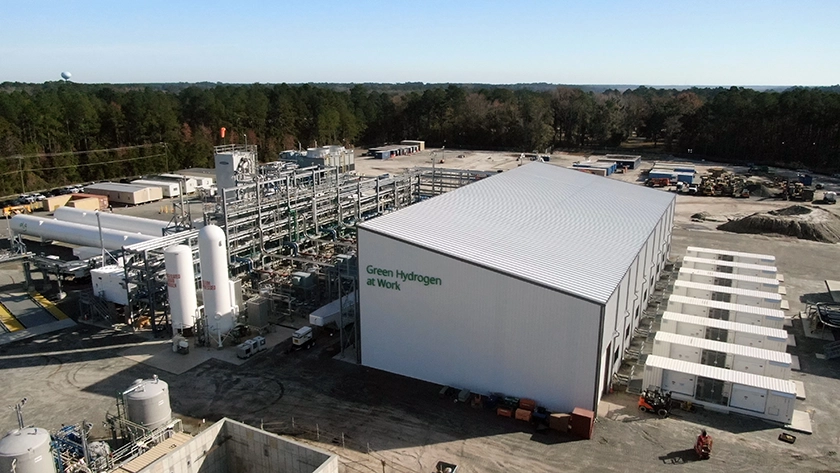The Sustainable Future of Generative AI: Hydrogen Fuel Cells
In the rapidly evolving landscape of technology, Generative Artificial Intelligence (AI) stands at the forefront, heralding a new era of innovation across industries. From creating stunningly realistic digital art to driving advancements in natural language processing, Generative AI is not just transforming how we interact with technology, it’s greatly expanding the number of applications technologies can be applied to.

Yet, beneath the surface of these groundbreaking developments lies an often-overlooked challenge: the substantial energy required to fuel these AI marvels. As we push the limits of artificial intelligence, the quest for sustainable, efficient power sources becomes increasingly critical.
Enter hydrogen fuel cells. These power generation systems offer a clean, efficient, and reliable energy source, making them an ideal match for the insatiable and ever-growing energy demands of Generative AI.
Unlike traditional fossil fuels, which come with a hefty environmental cost, hydrogen fuel cells generate electricity through a process that emits only water vapor, heralding a new age of eco-friendly innovation.
As technology rapidly advances, understanding how Generative AI and fuel cells can work together is crucial. This blog post looks at Plug’s leading role in the hydrogen fuel cell sector and how it can power the Generative AI revolution.
With a commitment to sustainability and innovation, Plug’s solutions not only address the pressing energy demands of AI technologies but also pave the way for a greener, more sustainable future.
Understanding Generative AI and Its Energy Demands
The Rise of Generative AI
In recent years, Generative AI has emerged from the depths of academic research to become a linchpin of technological advancement across the globe.
At its core, Generative AI is a subset of AI technologies capable of creating original content, be it text, images, audio, or even computer code. This capability marks a significant departure from traditional AI’s focus on data analysis and pattern recognition, pushing the boundaries of what machines can achieve.
From automating content creation to accelerating drug discovery, improving customer service, and streamlining design processes, Generative AI’s applications are vast and varied.
For instance, AI-generated artwork and deepfake technologies showcase the creative potential of these tools, while language models like OpenAI’s GPT series revolutionize how we interact with information, automating content creation and providing insights in natural, conversational language.
The implications – both positive and negative – of Generative AI extend far beyond convenience and efficiency. It is driving innovation, creating opportunities for new products and services, and even challenging our notions of creativity and authorship. As industries begin to harness its potential, Generative AI is set to become a fundamental driver of future technological landscapes.
The Power Behind AI
The brilliance of Generative AI, however, comes at a cost called energy. The computational power required to train these AI models is immense. Training a single AI model can consume as much electricity as a small town uses in a month.
ChatGPT, one of the widely used Generative AI tools uses 17,000 times more electricity than the average US household does daily.
This energy consumption is not just a technical challenge, it’s an environmental concern. Data centers, the physical homes of these AI operations, are energy-intensive facilities that often rely on non-renewable energy sources, contributing significantly to carbon emissions.
The environmental impact of AI’s energy consumption is a growing concern as these models become more complex and widespread. The demand for electricity in data centers hosting AI operations is expected to increase exponentially, highlighting the urgent need for sustainable solutions. This is where the role of green technologies, such as hydrogen fuel cells, becomes pivotal.
Generative AI’s future, while bright, hinges on our ability to meet its energy demands in a sustainable manner. The next sections will explore how hydrogen fuel cells offer a promising pathway to powering the AI revolution without compromising our planet’s health.
The Hydrogen Fuel Cell Solution
Introduction to Hydrogen Fuel Cells
At a time when the quest for sustainable energy sources is more critical than ever, hydrogen fuel cells emerge as a beacon of hope. Unlike traditional energy sources that rely on the combustion of fossil fuels, hydrogen fuel cells generate power through an electrochemical process that combines hydrogen and oxygen to produce electricity, water, and heat. This process, remarkably efficient and clean, produces zero emissions at the point of use, with water vapor being the only byproduct.
The scalability and flexibility of fuel cell technology make it particularly suitable for a wide range of applications, from powering vehicles and portable devices to providing backup power for data centers and full-scale electricity for industrial operations. For industries driven by the relentless demand for computational power, like those harnessing Generative AI, fuel cells offer a sustainable, reliable power source that can grow alongside expanding AI landscape.

Why Fuel Cells for AI?
The synergy between hydrogen fuel cells and Generative AI technologies lies in their mutual emphasis on innovation and sustainability.
As Generative AI pushes the boundaries of what technology can achieve, the energy it consumes becomes a pivotal factor in determining the sustainability of this progress.
Fuel cells, as a clean energy technology, present a solution that aligns with the forward-looking ethos of AI development.
The benefits of using hydrogen fuel cells for powering AI technologies include:
- Renewable Energy Generation: The hydrogen used by the fuel cell products can be produced through the electrolysis of water, powered by renewable energy sources such as wind and solar. This method aligns with global efforts to reduce carbon emissions and utilize renewable resources, making green hydrogen a key player in the sustainable energy landscape.
- Reliability and Environmental Benefit: Fuel cells are notable for their ability to provide steady, on-demand power, which is vital for data centers and computational facilities that require constant operation. This technology offers a significant environmental advantage by reducing dependence on fossil fuel-based generators, highlighting the path toward cleaner energy solutions for powering advanced technologies.
- Scalability: As AI technologies evolve and expand, the energy solutions powering them must adapt. Fuel cells can be scaled to meet increasing energy demands without sacrificing efficiency or environmental integrity.
In the context of Generative AI, where innovation and sustainability are paramount, fuel cells offer more than just energy—they provide a pathway to a future where technological advancement and environmental stewardship go hand in hand.
Plug’s Role in the AI Revolution
Plug’s Fuel Cell Innovations
Plug stands at the forefront of the hydrogen revolution, pioneering the development and deployment of hydrogen and fuel cell technology across various sectors. With a robust portfolio of fuel cell solutions designed for a wide range of applications, from material handling units to large-scale energy systems, Plug is driving the transition to a green energy future.
At the core of Plug’s mission is the commitment to innovation and sustainability, evident by our decades of work with fuel cells that were then leveraged into green hydrogen production. In 2023, Plug opened the country’s first green hydrogen production plant, that uses solar and wind sources to produce 15 tons of hydrogen per day. More production plants are under construction as Plug continues to pave the way for a future where energy solutions can be both green and practical.

Empowering Generative AI with Green Energy
The energy demands of Generative AI are vast and growing, but with great power comes great responsibility to the planet and future generations. Recognizing this, Plug’s fuel cells emerge as an essential solution for powering the data centers and computational infrastructures that underpin Generative AI technologies.
Plug’s fuel cells offer several advantages for the AI sector:
- Uninterrupted Power Supply: Guaranteeing the continuous operation of AI computations, essential for training and running large models without the risk of data loss or computational errors due to power interruptions.
- Reduced Carbon Footprint: Enabling AI technologies to grow in an environmentally sustainable way, aligning with global efforts to combat climate change.
- Scalable Solutions: As the adoption of Generative AI escalates, the need for scalable energy solutions becomes critical. Plug’s fuel cells can be efficiently scaled to meet this increasing demand, ensuring that the energy infrastructure keeps pace with technological advancements.
By integrating hydrogen fuel cells into the energy mix for AI technologies, Plug is not only addressing the immediate challenges of sustainability and reliability but also setting the stage for a future where innovation and environmental responsibility go hand in hand.
The efforts underscore the possibility, and necessity, of a symbiotic relationship between cutting-edge technology and clean energy solutions.
The Future Landscape
Market Trends and Forecasts
The trajectory of Generative AI is on an unprecedented rise, with applications spanning across industries, revolutionizing processes, and setting new standards for innovation.
This rapid growth is paralleled by an increasing awareness and demand for sustainable energy solutions, as businesses and societies grapple with the environmental impact of technological advancement.

Market trends indicate a significant shift towards clean energy, with hydrogen fuel cells expected to play a crucial role in powering everything from transportation to industrial processes, and critically, the data centers that are the backbone of Generative AI technologies.
As regulatory pressures increase and public demand for sustainability grows, companies leveraging and contributing to sustainable technologies like hydrogen are poised for unprecedented growth and influence.
The Road Ahead for Generative AI and Green Energy
The futures of Generative AI and clean energy are not just intertwined; they’re interdependent. The advancement of AI technologies depends on the development of sustainable, reliable energy solutions that can scale with the burgeoning energy demands of AI systems.
Plug, with its innovative fuel cell solutions, stands at the forefront of this revolution, offering a blueprint for how technology and sustainability can coexist and propel each other forward.
As we look to the future, the collaboration between AI innovators and clean energy leaders like Plug will become increasingly crucial. The potential of Generative AI to transform our world is immense but realizing that potential in a way that also preserves the planet requires commitment, innovation, and partnership across industries.
The journey toward a sustainable technological future is both a challenge and an opportunity, an opportunity to redefine progress, to innovate responsibly, and to demonstrate that the future of technology is not just smart, but green. With companies like Plug leading the way, the path to a sustainable, AI-powered future has never been more optimistic.
The post The Sustainable Future of Generative AI: Hydrogen Fuel Cells first appeared on Plug Power.
The post The Sustainable Future of Generative AI: Hydrogen Fuel Cells appeared first on Plug Power.